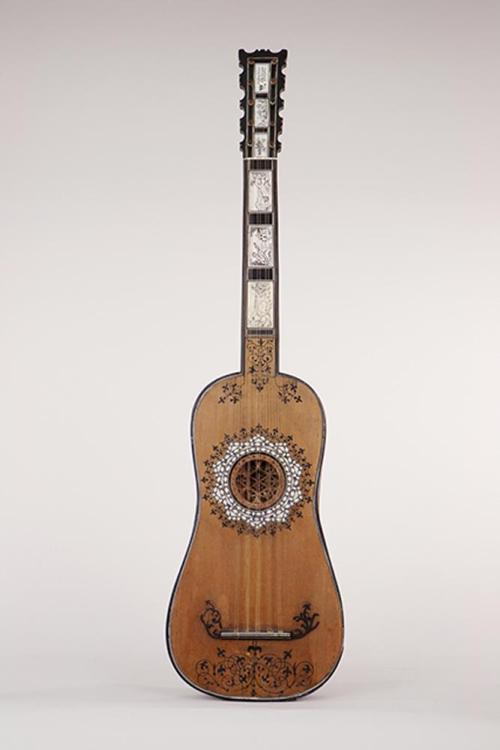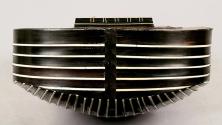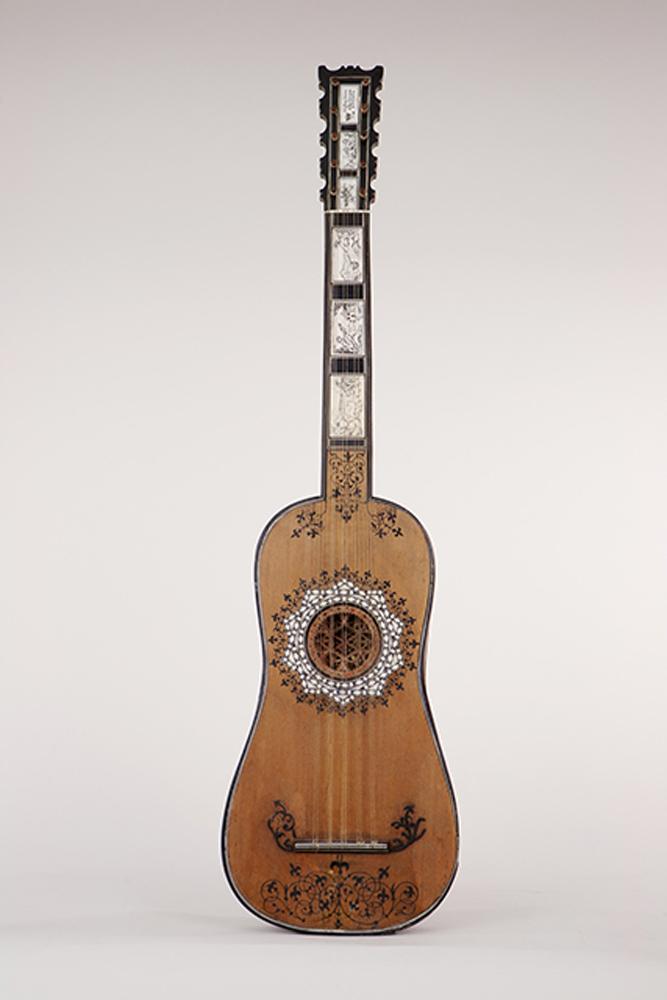Advanced Search
Plucked Strings
Guitars
Guitar
Maker: attributed to Matteo Sellas
Date: 1640 ca.
Place Made:Venice, Italy, Europe
Serial No: none
SignedEngraved and filled with black ink on later plaque on front of head: Mattheo Sellas / [crown] alla Corona / 1638. in Venetia
Markingsnone
DescriptionThe Sellas family of Venice immigrated from North of the Alps in the sixteenth century and became one of the principal suppliers of guitars, lutes, their components to not only Italy, but other areas of Europe. They engaged in mass production of instruments, which were sometimes shipped in parts and assembled at their point of sale. This beautifully decorated example is likely one of their higher-end products.
Stringing: five double courses
Top: two-piece spruce: fine grain, wood of top extends 51 mm over neck; bound in ebony with four-ply ebony and ivory strip trim
Back: arched shape with 25 fluted ebony ribs interspersed with ivory strips with rounded profiles; lined in brown paper
Ribs: 8 fluted ebony ribs interspersed with ivory strips with rounded profiles; ribs divided at endpin with ebony strip; lined in brown wood veneer
Head: 9-ply ebony and ivory; festooned outline; back with central ebony and ivory vine marquetry panel; front with three engraved, black-ink-filled ivory plates, probably replacements, one bearing signature, one wih reclining man, one with rose; ivory-ebony-ivory strip inlay trim on front and back
Neck: softwood wood, grain diagonal to plane of top, veneered with ebony and ivory vine marquetry on back; bordered with four-ply ebony and ivory strip trim; single 9.9 cm nail through neck block into neck; separate piece of softwood in neck heel
Fingerboard: ebony inlaid with three engraved, black-ink-filled ivory plates, one with fisherman bearing net, one with woman playing lute near building, and one with man aiming long gun with two hunting dogs in background; first two plates probably replacements; ebony and ivory strip trim around plates
Nut: bone
Bridge: two-part later ebony tie bridge divided by ivory strip, the upper edges trimmed with ivory strips, original ebony vine moustaches
Pegs: one old boxwood peg with integral pin; eight later brown hardwood pegs with slightly undercut heads and integral pins
End button: missing
Rose: four-tiered parchment rose with cardboard sides; painted orange and gold; parchment possibly recycled as some red lines not corresponding with pattern are visible under paint
Rosette: ivory diamond and dot inlay set into mastic; one circle immediately next to black-painted soundhole chamfer, enclosed in two interlocking pentagons with ebony and ivory strip trim
Neck block: rectangular wood (24 mm deep, 76 mm wide at joint with top on outer face, 71 mm wide at joint with top and ribs, about 80 mm at joint with back on outer face) with uneven, wide grain, perpendicular to plane of top; flanked with two pieces of softwood, probably spruce with fine grain parallel to plane of top
End block: rectangular wood with grain perpendicular to plane of top, the grain diagonal to lower rib (15 mm wide, 72 mm wide at the joint with top, 79 mm wide at joint with back)
Top braces: three soundboard braces, spruce. Top brace above soundhole, slightly angled, grain parallel to plane of soundboard, deep and narrow with tapered concave ends (21 x 8.5 mm); brace below sound hole, glued in an angled positions, with tapered concave ends (20 x 9 mm), grain running diagonal to plane of soundboard; lower bout brace, under the actual bridge position, trapezoidal profile section, wide grain running diagonal to plane of soundboard (14x11 mm)
Top decoration: incised and black mastic filled vine and spear inlay at upper and lower parts of top and around soundhole
Stringing: five double courses
Top: two-piece spruce: fine grain, wood of top extends 51 mm over neck; bound in ebony with four-ply ebony and ivory strip trim
Back: arched shape with 25 fluted ebony ribs interspersed with ivory strips with rounded profiles; lined in brown paper
Ribs: 8 fluted ebony ribs interspersed with ivory strips with rounded profiles; ribs divided at endpin with ebony strip; lined in brown wood veneer
Head: 9-ply ebony and ivory; festooned outline; back with central ebony and ivory vine marquetry panel; front with three engraved, black-ink-filled ivory plates, probably replacements, one bearing signature, one wih reclining man, one with rose; ivory-ebony-ivory strip inlay trim on front and back
Neck: softwood wood, grain diagonal to plane of top, veneered with ebony and ivory vine marquetry on back; bordered with four-ply ebony and ivory strip trim; single 9.9 cm nail through neck block into neck; separate piece of softwood in neck heel
Fingerboard: ebony inlaid with three engraved, black-ink-filled ivory plates, one with fisherman bearing net, one with woman playing lute near building, and one with man aiming long gun with two hunting dogs in background; first two plates probably replacements; ebony and ivory strip trim around plates
Nut: bone
Bridge: two-part later ebony tie bridge divided by ivory strip, the upper edges trimmed with ivory strips, original ebony vine moustaches
Pegs: one old boxwood peg with integral pin; eight later brown hardwood pegs with slightly undercut heads and integral pins
End button: missing
Rose: four-tiered parchment rose with cardboard sides; painted orange and gold; parchment possibly recycled as some red lines not corresponding with pattern are visible under paint
Rosette: ivory diamond and dot inlay set into mastic; one circle immediately next to black-painted soundhole chamfer, enclosed in two interlocking pentagons with ebony and ivory strip trim
Neck block: rectangular wood (24 mm deep, 76 mm wide at joint with top on outer face, 71 mm wide at joint with top and ribs, about 80 mm at joint with back on outer face) with uneven, wide grain, perpendicular to plane of top; flanked with two pieces of softwood, probably spruce with fine grain parallel to plane of top
End block: rectangular wood with grain perpendicular to plane of top, the grain diagonal to lower rib (15 mm wide, 72 mm wide at the joint with top, 79 mm wide at joint with back)
Top braces: three soundboard braces, spruce. Top brace above soundhole, slightly angled, grain parallel to plane of soundboard, deep and narrow with tapered concave ends (21 x 8.5 mm); brace below sound hole, glued in an angled positions, with tapered concave ends (20 x 9 mm), grain running diagonal to plane of soundboard; lower bout brace, under the actual bridge position, trapezoidal profile section, wide grain running diagonal to plane of soundboard (14x11 mm)
Top decoration: incised and black mastic filled vine and spear inlay at upper and lower parts of top and around soundhole
Dimensions(taken by Darryl Martin, May 2006)
Overall length: 962 mm
Body length: 472 mm
Upper bout width: 199 mm
Center bout width: 175 mm
Lower bout width: 256 mm
Neck length: 317 mm
Neck width at nut: 49.7 mm
Neck width at body: 56.4 mm
Head length: 185 mm
Head width at nut: 50.2 mm
Head width at top: 74.4 mm
Head depth: 12.1 mm
Body depth (range); 59.6 mm to 97.5 mm
Rose diameter: 77.9 mm
Vibrating string length: 690 mm
Overall length: 962 mm
Body length: 472 mm
Upper bout width: 199 mm
Center bout width: 175 mm
Lower bout width: 256 mm
Neck length: 317 mm
Neck width at nut: 49.7 mm
Neck width at body: 56.4 mm
Head length: 185 mm
Head width at nut: 50.2 mm
Head width at top: 74.4 mm
Head depth: 12.1 mm
Body depth (range); 59.6 mm to 97.5 mm
Rose diameter: 77.9 mm
Vibrating string length: 690 mm
ProvenanceFrom the Bisiach Collection, Venegono Superiore, Italy, acquired by Laurence Witten from the heirs, 1968.
Purchased by the National Music Museum from Laurence Witten family, New Haven, Connecticut, 1984.
Purchased by the National Music Museum from Laurence Witten family, New Haven, Connecticut, 1984.
Terms
Credit Line: Witten-Rawlins Collection, 1984
Not on view
Published ReferencesAndré P. Larson, "Early Italian Plucked Stringed Instruments at the Shrine to Music Museum," Lute Society of America Newsletter Vol. XX, No. 1 (February 1985), p. 8.
André P. Larson, The National Music Museum: A Pictorial Souvenir (Vermillion: National Music Museum, 1988), inside front cover, cover & p. 40.
ClassicNotes: KDFC 102.1 FM (San Francisco) 11, No. 3, Issue #7 (Spring 1996), cover.
Catherine Patrick, “Overhauling Vermillion’s Ode to the Opus: Expansion of National
Music Museum building in the works,” The Volante (April 15, 2009), pages B1, B3.
James Westbrook and Ted Fuller, The Complete Illustrated Book of the Acoustic Guitar (Wigston, UK: Lorenz Books, 2012), p. 5.
André P. Larson, The National Music Museum: A Pictorial Souvenir (Vermillion: National Music Museum, 1988), inside front cover, cover & p. 40.
ClassicNotes: KDFC 102.1 FM (San Francisco) 11, No. 3, Issue #7 (Spring 1996), cover.
Catherine Patrick, “Overhauling Vermillion’s Ode to the Opus: Expansion of National
Music Museum building in the works,” The Volante (April 15, 2009), pages B1, B3.
James Westbrook and Ted Fuller, The Complete Illustrated Book of the Acoustic Guitar (Wigston, UK: Lorenz Books, 2012), p. 5.
Object number: 03385





























